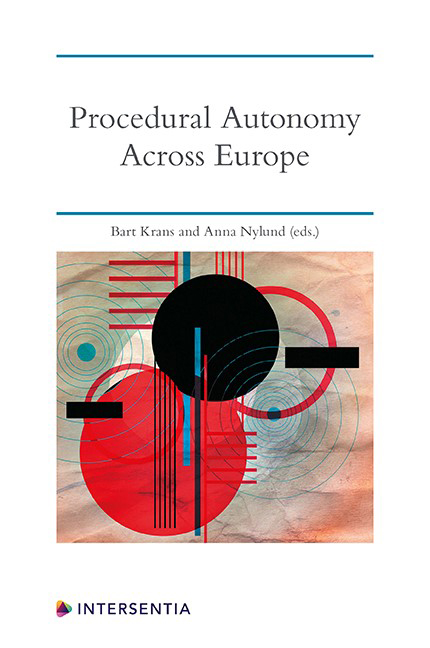Book contents
- Frontmatter
- Preface
- Contents
- Table of Cases
- List of Authors
- Aspects of Procedural Autonomy
- Procedural Autonomy and Belgian Civil Procedure Law: A Turbulent Cohabitation
- The English Approach to Procedural Autonomy
- The Finnish Way of Understanding Procedural Autonomy: A Practical Approach to Implementing EU Civil Procedural Law
- A German Perspective on the Waning Procedural Autonomy in Civil Matters: Who is Afraid of European Civil Procedure?
- Procedural Autonomy in the Netherlands: A Fading Relic?
- Procedural Autonomy, the EEA Agreement and Norwegian Law: The Art of Bridging a Gap and Maintaining it Too
- A Polish Perspective on Collective Civil Proceedings: Reluctance to Follow EU Recommendations?
- Procedural Autonomy between EU Law and the Slovenian Law of Civil Procedure
- Autonomy of the Spanish Legislator in the Regulation of Procedural Law: The Borders of European Case Law
- Procedural Autonomy in Sweden: Is Materielle Prozessleitung the Answer?
- Comparative Insights on Procedural Autonomy
- Index
- ABOUT THE EDITORS
A German Perspective on the Waning Procedural Autonomy in Civil Matters: Who is Afraid of European Civil Procedure?
Published online by Cambridge University Press: 30 April 2020
- Frontmatter
- Preface
- Contents
- Table of Cases
- List of Authors
- Aspects of Procedural Autonomy
- Procedural Autonomy and Belgian Civil Procedure Law: A Turbulent Cohabitation
- The English Approach to Procedural Autonomy
- The Finnish Way of Understanding Procedural Autonomy: A Practical Approach to Implementing EU Civil Procedural Law
- A German Perspective on the Waning Procedural Autonomy in Civil Matters: Who is Afraid of European Civil Procedure?
- Procedural Autonomy in the Netherlands: A Fading Relic?
- Procedural Autonomy, the EEA Agreement and Norwegian Law: The Art of Bridging a Gap and Maintaining it Too
- A Polish Perspective on Collective Civil Proceedings: Reluctance to Follow EU Recommendations?
- Procedural Autonomy between EU Law and the Slovenian Law of Civil Procedure
- Autonomy of the Spanish Legislator in the Regulation of Procedural Law: The Borders of European Case Law
- Procedural Autonomy in Sweden: Is Materielle Prozessleitung the Answer?
- Comparative Insights on Procedural Autonomy
- Index
- ABOUT THE EDITORS
Summary
STARTING POINT: PROCEDURAL AUTONOMY AS A MATTER OF HIERARCHY OF RULES
According to Article 81 TFEU, the EU is competent to harmonise procedural rules for judicial cooperation in civil matters with cross-border implications. This explicitly includes the elimination of obstacles to the proper functioning of civil proceedings, if necessary, by promoting the compatibility of the rules on civil procedure applicable in the Member States (Article 81(2)(f )). In contrast, the legislative competence of the EU to harmonise or at least approximate civil procedure is much more limited as regards mere domestic disputes, because, in this respect, the TFEU contains no general legal base equivalent to Article 81. On the other side of that coin is what is often referred to as ‘procedural autonomy of the Member States’ (in German, usually referred to as ‘Verfahrensautonomie der Mitgliedstaaten’): in principle, it is for each national legal system to designate which court has jurisdiction and to determine the procedural conditions governing actions at law to ensure the protection of rights of individuals.
Below the line, however, procedural autonomy is limited and increasingly waning, if not eroding. Firstly, national procedural rules are only applicable in so far as they are consistent with higher-ranking principles:
In accordance with the principle of sincere cooperation enshrined in Article 4(3) TEU, the detailed procedural rules governing actions for safeguarding an individual's rights under EU law must be no less favourable than those governing similar domestic actions (principle of equivalence) and must not render impossible in practice or excessively difficult the exercise of rights conferred by EU law (principle of effectiveness).
Secondly, several provisions of the TFEU (such as Articles 114, 115 and 169) allow for the adoption of measures for the approximation of the laws of the Member States. While such rules primarily aim at the harmonisation of substantive law in a number of areas of private law (for example, consumer protection, anti-discrimination, insurance law, labour law, company law and competition law), it is generally recognised that they can also serve as a legal basis for uniform procedural rules or standards even in purely domestic civil cases. In this context, it should be noted that such EU requirements can go far beyond the simple effectiveness test normally applied in the context of procedural autonomy.
- Type
- Chapter
- Information
- Procedural Autonomy Across Europe , pp. 81 - 100Publisher: IntersentiaPrint publication year: 2020
- 2
- Cited by

